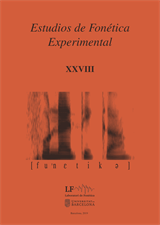DiapixSp: adaptation to Spanish and exploratory application of a tool to elicit spontaneous and collaborative speech
Keywords:
Diapix, DiapixSp, Elicitation tool, Spontaneous speechAbstract
This article presents the results of the adaptation and pilot testing of a new tool aiming at eliciting collaborative and spontaneous speech in Spanish, called “DiapixSp”, inspired in the “Diapix” task family, of recent creation (Van Engen, Baese-Berk, Choi y Bradlow, 2010; Baker y Hazan, 2011; Wester, Lecumberri y Cooke, 2014). After reviewing the theoretical foundations justifying and guiding the creation of elicitation tasks, and after revising previous research conducted using other “Diapix” materials, the new task is introduced: it is an elicitation task for spontaneous speech, which works via a collaborative “find the differences” game, in pairs, using pictures belonging to four semantic domains. The pilot test was conducted with 20 subjects (10 pairs), females and males, native speakers of Chilean Spanish. The analysis of the corpus showed that DiapixSp is (a) capable of generating sufficient linguistic materials, (b) that the contributions of the members of each pair tend to be balanced, (c) that the task does not lead to learning or training effects, and (d) that the different semantic domains show a tendency to elicit a comparable amount of linguistic materials. The results of the pilot also show that DiapixSp succeeds at eliciting spontaneous speech, despite the fact that its format allows for some control of the communication situation and the type of linguistic structures that will be elicited, and despite the fact that its application requires relatively few economic and time resources.
References
BAKER, R., y V. HAZAN (2011): «DiapixUK: task materials for the elicitation of multiple spontaneous speech dialogs», Behavior Research Methods, 43(3), pp. 761-770.
BELL, A. (1984): «Language style as audience design», Language in society, 13(2), pp. 145-204.
BOERSMA, P., y D. WEENINK (2018): «Praat: doing phonetics by computer» [programa computacional], versión 6.0.39, descargado el 3 de abril de 2018 de http://www.praat.org/
BRIZ GÓMEZ, A. (2010a): «El registro como centro de la variedad situacional. Esbozo de la propuesta del grupo Val.Es.Co. sobre las variedades diafásicas», en I. Fonte y L. Rodríguez Alfano (compiladoras): Perspectivas dialógicas en estudios del lenguaje, México, Universidad Autónoma de Nuevo León, pp. 21-56.
BRIZ GÓMEZ, A. (2010b): El español coloquial: Situación y uso, Madrid, Arco Libros.
BRIZ GÓMEZ, A. (2014): El español coloquial en la conversación, Barcelona, Ariel Lingüística.
BROWN, G., A. ANDERSON, R. SHILLCOCK y G. YULE (1985): Teaching talk: Strategies for production and assessment, Cambridge, Cambridge University Press.
CANDIA, L., Z. MERELLO y H. VALDIVIESO (1985): «Fonética aplicada: Diagnóstico y tratamiento de deficiencias en la lectura en voz alta», Revista de lingüística teórica y aplicada, (23), pp. 89-106.
CHAMBERS, J. K. y P. TRUDGILL (1980): Dialectology, Cambridge, Cambridge University Press.
CIFUENTES BECERRA, E., y G. F. SALAMANCA GUTIÉRREZ (2012): «Desarrollo y aplicación piloto de un instrumento para recoger datos del nivel fonético-fonológico», Literatura y lingüística, (25), pp. 221-248.
COOKE, M., y Y. LU (2010): «Spectral and temporal changes to speech produced in the presence of energetic and informational maskers», The Journal of the Acoustical Society of America, 128, pp. 2059-2069.
CRAWFORD, M. D., G. J. BROWN, M. P. COOKE y P. D. GREEN (1994): «The design, collection and annotation of a multi-agent, multisensor speech corpus», Proceedings of the Institute of Acoustics, 16, pp. 183–189.
FASOLD, R. (1996): La sociolingüística de la sociedad. Introducción a la sociolingüística, Madrid, Visor Libros.
GARCÍA MARCOS, F. (1993): Nociones de sociolingüística, Barcelona, Octaedro.
GARCÍA, D. (2017). DiapixCl: Adaptación al español de una herramienta de elicitación de habla espontánea (Tesis de Grado), Universidad de Concepción, Chile.
GOLDMAN, J. P. (2011): «EasyAlign: an automatic phonetic alignment tool under Praat», Proceedings of InterSpeech, septiembre de 2011, Florencia, Italia.
HALLIDAY, M. A. K. (1994): El lenguaje como semiótica social. La interpretación social del lenguaje y del significado, Bogotá, Fondo de Cultura Económica.
KIRK, R. E. (1990). Statistics: An introduction. Fort Worth, Texas, Holt, Rinehart & Winston.
LABOV, W. (1983): Modelos sociolingüísticos, Madrid, Cátedra.
LAMBERT, W. E. (1967): «A social psychology of bilingualism», Journal of Social Issues, 23(2), pp. 91-109.
LLISTERRI BOIX, J. (1991): Introducción a la fonética: el método experimental, Barcelona, Anthropos.
LÓPEZ MORALES, H. (1993): Sociolingüística, Madrid, Gredos.
MORENO FERNÁNDEZ, F. (1990): Metodología sociolingüística, Madrid, Gredos.
SAMARIN, W. J. (1967): Field Linguistics. A Guide to Linguistic Field Work, New York, Holt, Rinehart and Winston.
SILVA-CORVALÁN, C. (1989): Sociolingüística. Teoría y análisis, Madrid, Alhambra.
SILVA-CORVALÁN, C. (2001): Sociolingüística y Pragmática del español, Washington D.C., Georgetown University Press.
VAN ENGEN, K. J., M. BAESE-BERK, R. E. BAKER, A. CHOI, M. KIM, y A. R. BRADLOW (2010): «The Wildcat Corpus of native-and foreign-accented English: Communicative efficiency across conversational dyads with varying language alignment profiles», Language and speech, 53(4), pp. 510-540.
WESTER, M., M. L. G. LECUMBERRI y M. COOKE (2014): «DIAPIX-FL: A symmetric corpus of problem-solving dialogues in first and second languages», Fifteenth Annual Conference of the International Speech Communication Association, septiembre de 2014, Singapur.
Downloads
Published
How to Cite
Issue
Section
License

This work is licensed under a Creative Commons Attribution-NonCommercial-NoDerivatives 4.0 International License.
All articles published online by Estudios de Fonética Experimental are licensed under Creative Commons Attribution-NonCommercial-NoDerivs 4.0 International (CC BY-NC-ND 4.0 DEED), unless otherwise noted. Estudios de Fonética Experimental is an open access journal. Estudios de Fonética Experimental is hosted by RCUB (Revistes Científiques de la Universitat de Barcelona), powered by Open Journal Systems (OJS) software. The copyright is not transferred to the journal: authors hold the copyright and publishing rights without restrictions. The author is free to use and distribute pre and post-prints versions of his/her article. However, preprint versions are regarded as a work-in-progress version used as internal communication with the authors, and we prefer to share postprint versions.




